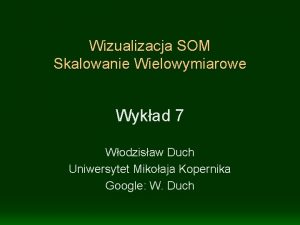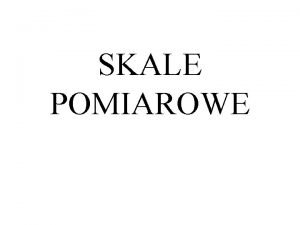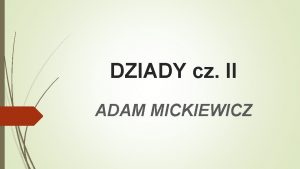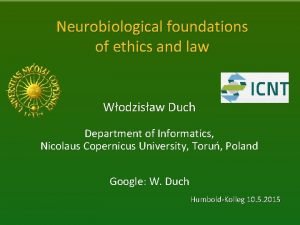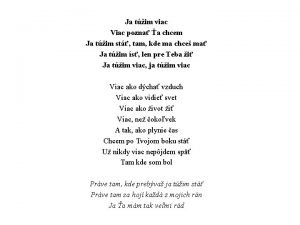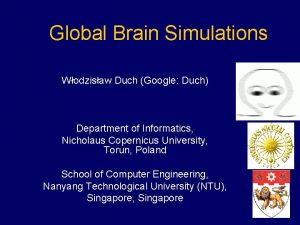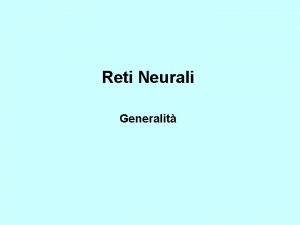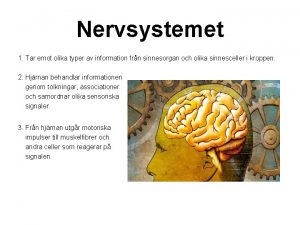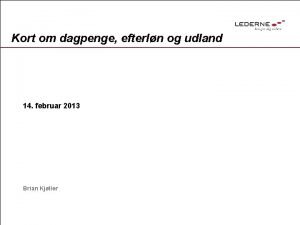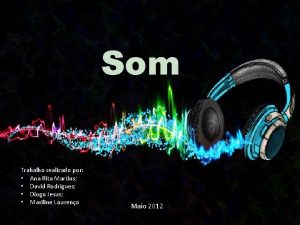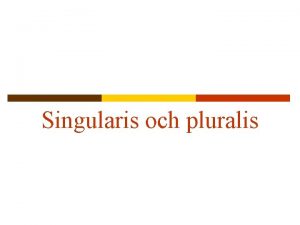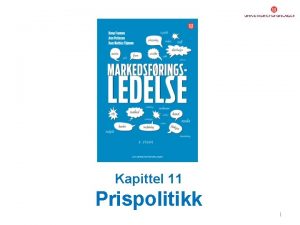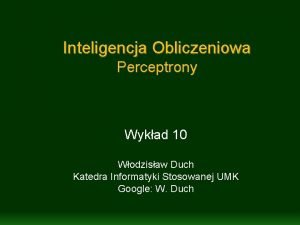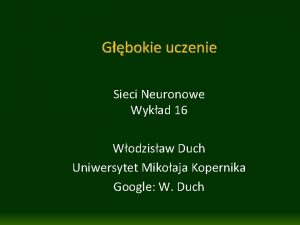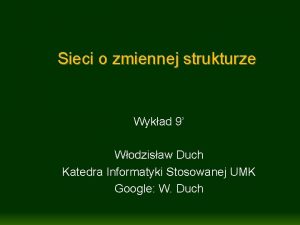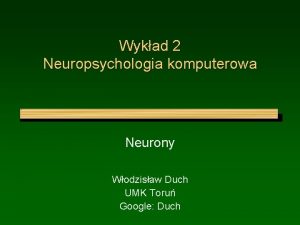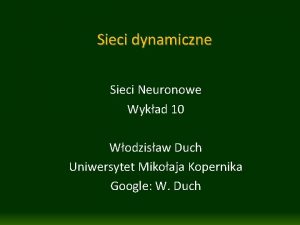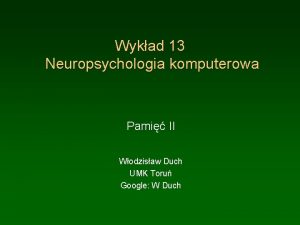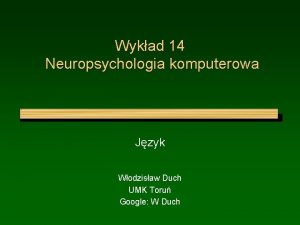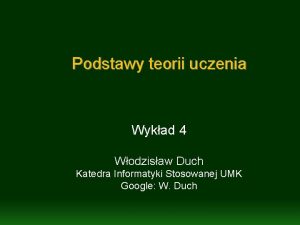Wizualizacja SOM Skalowanie Wielowymiarowe Wykad 7 Wodzisaw Duch

































- Slides: 33

Wizualizacja SOM Skalowanie Wielowymiarowe Wykład 7 Włodzisław Duch Uniwersytet Mikołaja Kopernika Google: W. Duch

Problemy z SOM • SOM and its variants become so popular because they allow for visualization of data clusters, unsupervised classification. • SOM does not guarantee faithful approximation to probability density of data samples (too many nodes are placed in areas with a few vectors only), but there are ways to correct it: Ex: M. Van Hulle, Faithful Representations and Topographic Maps From Distortion to Information-based Self-organization. Wiley 2000 • Quantization error is useful as an estimate of the quality of approximation by SOM, but it is not useful to measure distortions in visualization. • How to visualize clusters in topographically correct way? Multi-Dimensional Scaling, MDS, is our best answer.

MDS: idea • MDS, Multi-Dimensional Scaling (Thorton 1954, Kruskal 1964), zwane także mapowaniem Sammona Sammon 1964) Inspirations mostly from psychology, or psychometrics! Problem: visual representation of dissimilarity data. • Information about the clusters in data is in relations between maxima of probability densities of finding data vectors. • Visualization of multidimensional data leads to some topographical distortions, so a measure of these distortions is required. • How different are the distances in the original, d-dimensional space, and in the target space, usually 2 -dimensional?

MDS algorytm • Data (feature) space X Rd, vectors X(i), i=1. . n represented by points Y in the target space, usually Y R 2. • Distances Rij = ||X(i)-X(j)|| between X(i) and X(j) in feature space Rd; distances rij = ||Y(i)-Y(j)|| in target space R 2. • Find mapping X Y=M(X) that minimizes some global index of topographical distortion, based on differences between Rij and rij. r=r(Y), so E(r) depends on 2 n adaptive parameters Y; 3 are redundant: Y(1)=(0, 0)T, choosing coordinate center, and Y 1(2)=0 choosing orientation of the coordinate center. Initialize Y randomly or using PCA, minimize E(r(Y))

Miary zniekształceń Any non-negative function f(Rij, rij) may be used. Weights may depend on the distance, for example decreasing exponentially for large Rij distances. Various normalization factors may be introduced, but those that do not depend on the rij distances have no influence on the MDS map. Information loss; 0 = no loss, perfect representation, 1 = all lost, no info, ex. rij=0

Klasyczne miary MDS Stress (Kruskal), or absolute error, large distances may dominate, preserves overall cluster structure. Sammon measure, or intermediate error, contributions from large distances is reduced. Relative error, all distance scales treated in the same way. Alienation coefficient (Guttman. Lingoes) – similar to relative error, but more difficult to minimize.

Metryczny i nie-metryczny MDS does not require original X vectors, only Rij distances, that may be interpreted as dissimilarities of X(i) and X(j) objects. Gradient iterative minimization procedures for MDS may be formulated, but the problem is difficult: 2 n-3 variables for minimization, stress and other functions have multiple minima. 2 5 Sometimes its easy 3 1 4 3 Some measurements (especially in psychology) are very inaccurate. Instead of precise distances ordinal, or non-metric, information may be used, if ranking is established: X 1 is more similar to X 2 than to X 3. Measures of distortions use Dij = F(Rij), where F() may be any function preserving the ranking.

MDS vs. SOM Questions: 1) How good are SOM maps (in the sense of MDS measures)? (not quite fair, because SOM does not optimize these!) 2) How optimal maps look like ? Problem: there is no function mapping X Y ! Adding new point on the map requires new minimization; mapping function may be written only for a fixed number of points. Maps with large stress: zoom on smaller areas, avoid large topographical distortions. SOM does classification and visualization, but separating these to functions may improve accuracy of both. MDS and SOM – sensitive to noise in data (irrelevant features).

MDS vs. PCA MDS may start from random positions of points, moving them to minimize the measure of topographical distortions, results may strongly depend on the starting point. Multi-starts are recommended, followed by selection of the best configuration (with lowest stress value). PCA may be a good starting point for MDS, although PCA is only a linear method and does not preserve distances between points. For n data vectors and d dimensions: PCA requires building the dxd covariance matrix, with complexity O(nd 2) and diagonalization of this matrix, complexity O(d 3). MDS requires calculation of a distance matrix O(n 2 d) and minimization procedure of 2 n-3 parameters. Some data has d=104, and n=100; other data has d=10, and n=104. . . which method to use?

Hipersześciany

Hipersześciany 5 D + sfery w 3 D

Sympleksy 6 -11

Sympleksy 15 -20 D

Sekwencje rodziny białek Globin 226 protein sequences of the Globin family; similarity matrix shows high similarity values (dark spots) within subgroups, MDS shows cluster structure of the data (from Klock & Buhmann 1997).

Podobieństwo twarzy 300 faces, similarity matrix evaluated and Sammon mapping applied (from Klock & Buhmann 1997).

Mapy semantyczne How to capture the meaning of words/concepts? It is contained in properties of concepts, their semantic relations. Simplest example - take 8 birds and 8 mammals: dove, hen, duck, goose, owl, hawk, eagle, fox, dog, wolf, cat, tiger, lion, horse, zebra, cow. Create some concept descriptions, for example use 13 binary features: • • size is: small, medium large; has 2 legs, 4 legs, has hair, hoofs, mane, feathers; likes to: hunt, run, fly, swim. Form sentences that describe these 16 animals using 13 features. More complex description should give more relations and features.

Zdania opisujące zwierzęta Dove is small, has 2 legs, has feathers, likes to fly. Hen is small, has 2 legs, has feathers. Duck is small, has 2 legs, has feathers, likes to swim. Horse is big, has 4 legs, mane, hair, hoofs, likes to run. This is a common sense knowledge that may be represented in a vector space and collected in data table. Assign a vector of properties to each animal: V(horse)= [small=0, medium=0, large=1, has 2 legs=0, 4 legs=1, . . . ] = [0, 0, 1, 1, 0, 0] Map these 13 D vectors in 2 D to see relations between them.

Przykład mapy semantycznej SOM was used on such data by Ritter and Kohonen 1989, MDS by Naud & Duch (1996).

Porównanie map MDS & SOM MDS and SOM was used on data vectors from the previous page.

Uwagi na temat map semantycznych Natural classification of animals, preserving their similarity: mammals are separated from birds, hunters from grass-eaters, small animals separated from large. Similarity of animals is related to the distance on toposemantic map. Psychological experiments provide a matrix of perceived similarities: this is derived either from frequencies of answers to questions like: what other animal is similar to horse? Sometimes response times to questions are also measured. Information Retrieval: use concepts spaces, properties derived automatically from context information, to set up vectors representing words, phrases, concepts. This allows for semantic retrieval of information.

MDS na danych empirycznych MDS was used on data from psychological experiments with perceived similarity between animals: note that it is very similar to previous maps.

Przykłady MDS Demonstrations: some examples of MDS maps made with the Ghost. Miner software http: //www. fqspl. com. pl/ghostminer/ Few lessons from visualization of: • parity data – shows structure that is not visible with other methods, but very sensitive to starting point; • medical data (from Lancet) – shows subgroups of different types of cancer, that can be labeled and identified; • liver diseases 4 -class data – show that same patients were used several times, leading to excellent results from the nearest neighbor methods; • DNA promoters data – shows the importance of feature transformations.

MDS – książki i strony Schiffman S. M, Reynolds L, Young F. W. Introduction to MDS. 1981 Cox T. F, Cox M. A. A, Multidimensional Scaling, 2 nd ed, 2001 Borg, I. and Groenen, P. J. F. Modern MDS. 2 nd ed, Springer 2005. Elementary introduction to MDS algorithms described in details. Asymmetry MDS package - dla wizualizacji niesymetrycznych! MDS (Multi Dimensional Scaling) page High-Throughput Multidimensional Scaling (Hi. T-MDS) Nasze demo MDS: women psychometry data Nasz pakiet Viser - wiele form wizualizacji szeregów czasowych.

Inne sposoby wizualizacji SNE, Dane dynamiczne:

Inspiracje nerobiologiczne Symulator Emergent: Aisa, B. , Mingus, B. , and O'Reilly, R. The emergent neural modeling system. Neural Networks, 21, 1045, 2008. Model czytania, uwzględnia ortografię, fonologię i semantykę, definiowaną przez aktywacje 140 mikrocech określających własności pojęć. Pomiędzy tymi 3 warstwami mamy ukryte neurony. Na razie szczegóły nie są istotne, ważna jest reprezentacja wyników zmieniającej się w czasie aktywacji: co iterację mamy inną macierz aktywacji warstwy semantycznej – czasami zmiany są powolne, czasami szybkie. Wokół nauczonych pojęć mamy „baseny atrakcji”, system spowalnia, zmiany przez jakiś czas są niewielkie, fluktuacje.

Wykresy rekurencji Trajektorie w wielu wymiarach można analizować za pomocą wykresów rekurencji (RP). Dla danego punktu na trajektorii robimy wykres we współrzędnych (t, t’) by pokazać odległość – binarie jeśli bliżej niż próg, lub w kolorze, zależnie od odległości. Mamy dyskretny czas, macierz rekurencji S() pokazuje przybliżone odległości punktów na trajektorii w dwóch chwilach czasu (iteracji). N. Marwan et al, Recurrence plots for the analysis of complex system. Physics Reports 438 (2007) 237– 329

Startując ze słówka „gain” widać skoki od atraktora do atraktora, ale nie widać jakie to atraktory.

Fuzzy Symbolic Dynamics (FSD) Dodatkowe informacje do wykresów RP: FSD 1. Dane standaryzowane: wariancja =1. 2. Szukamy klastrów w danych: m 1, m 2. . . 3. Nieliniowa transformacja pokazuje punkty: Zlokalizowane funkcje przynależności yk(t; W): Binarne funkcje progowe => dynamika symboliczna; x(t) => ciągi symboli. Funkcje rzeczywiste => rozmyta dynamika symboliczna, redukcja wymiarowości Y(t)=(y 1(t; W), y 2(t; W)) => wizualizacja danych o wielu wymiarach. Wizualizacja pokazuje baseny atrakcji.

Porównanie FSD i RP pokazują baseny atrakcji, FSD wymaga dobrania odpowiednich położeń funkcji.

Długie trajektorie RP i MDS dla 40 słów tworzących mikrodomenę w modelu czytania. Spontaniczne przejścia pomiędzy atraktorami.

Prototype Data Plots dla przejść międyz atraktorami, zaczynając od „flag”

Graf przejść pomiędzy pojęciami, uśredniony po 10 razach. Dlaczego taki? Połączone pojęcia mają wspólne mikrocechy. Neurony je kodujące męczą się i ulegają desynchronizacji, słabiej pobudzone się ze sobą synchronizują i tworzą nowy rozkład wokół jakiegoś atraktora.

Interesujące wizualizacje Wiki on data visualization And for fun see quite different visualizations: http: //www. liveplasma. com Music scene Last. fm Raw. Graphs Cytoscape
 Skalowanie wielowymiarowe
Skalowanie wielowymiarowe Skala interwałowa
Skala interwałowa V pravde zil som
V pravde zil som Lennox vision
Lennox vision Mickiewicz prezentacja
Mickiewicz prezentacja Lau duch
Lau duch Protestantská etika a duch kapitalismu
Protestantská etika a duch kapitalismu Vdaka jezis akordy
Vdaka jezis akordy W zdrowym ciele zdrowy duch wikipedia
W zdrowym ciele zdrowy duch wikipedia Gołębica duch święty
Gołębica duch święty Duch prorocki a wróżby
Duch prorocki a wróżby Patryk duch
Patryk duch Príď svätý duch vojdi do nás
Príď svätý duch vojdi do nás Symboly ducha svätého
Symboly ducha svätého Google duch
Google duch Duch
Duch Formułka pragniemy, aby duch święty
Formułka pragniemy, aby duch święty Hebrajskie duch to
Hebrajskie duch to Application of som
Application of som Reti som
Reti som Halten av transmittorsubstanser som utsöndras
Halten av transmittorsubstanser som utsöndras Stoppad pall som gett namn åt statsrådsämbete
Stoppad pall som gett namn åt statsrådsämbete Pistola rima
Pistola rima Adjektiv som börjar på r
Adjektiv som börjar på r Ja som s vami po všetky dni až do skončenia sveta
Ja som s vami po všetky dni až do skončenia sveta Umkc hematology oncology fellowship
Umkc hematology oncology fellowship Dậy thổi cơm mua thịt cá
Dậy thổi cơm mua thịt cá Vem räknas som jude
Vem räknas som jude Overskydende timer dagpenge
Overskydende timer dagpenge Www.menti-com
Www.menti-com Trabalhos sobre o som
Trabalhos sobre o som Kom til mig alle i som slider jer trætte
Kom til mig alle i som slider jer trætte Plural lorry
Plural lorry Prispolitikk definisjon
Prispolitikk definisjon
